 Myth 1: ALL research indicates students should ALWAYS be socially promoted, even if they are far below expected proficiency in reading in 3rd grade.
Myth 1: ALL research indicates students should ALWAYS be socially promoted, even if they are far below expected proficiency in reading in 3rd grade.
Reality: Over a dozen studies show the benefits of performance-based promotion systems for several states using the Florida model reading intervention program, including the intervention strategy of having a minimum 3rd-grade reading standard for promotion.
Most studies critical of retention as an intervention strategy assume a child will simply repeat a year of the same coursework with the same or similar teacher. Few retention-critical studies account for programs with comprehensive reading interventions before and after the retention decision, as in the Alaska Reads Act. Most of the studies I’ve reviewed that are critical of retention also agree that retention employed at younger ages has fewer harmful effects.
14 Studies showing positive effects of performance-based promotion policies
- The Costs and Benefits of Test-Based Promotion
https://papers.ssrn.com/sol3/papers.cfm?abstract_id=3222671
2. The effects of test-based retention on student outcomes over time: Regression discontinuity evidence from Florida
https://www.sciencedirect.com/science/article/abs/pii/S004727271730097X
3. The Benefits of Florida’s Test-Based Promotion System
https://www.manhattan-institute.org/html/benefits-floridas-test-based-promotion-system-5850.html
- Ending Social Promotion Without Leaving Children Behind
https://www.rand.org/pubs/monographs/MG894.html
- Revisiting Grade Retention: An Evaluation of Florida’s Test-Based Promotion Policy
https://www.mitpressjournals.org/doi/10.1162/edfp.2007.2.4.319
- Third Grade Retention Policy Leading to Better Student Performance Statewide
https://www.oppaga.state.fl.us/reports/pdf/0666rpt.pdf
- Getting Farther Ahead by Staying Behind
https://media4.manhattan-institute.org/pdf/cr_49.pdf
- State Highlights: K-3 Comprehensive Reading Programs
- Mississippi’s Literacy Based Promotion Act: An Inside Look
https://www.excelined.org/wp-content/uploads/2019/03/ExcelinEd.MSGatewaytoSuccess.March2019.pdf
- Indiana Public Law 109: An Inside Look
- Nevada Read by Grade Three: An Inside Look
- South Carolina Read to Succeed: An Inside Look
- North Carolina Read to Achieve: An Inside Look
- Michgan’s Read by Grade Three Law: An Inside Look
Myth 2: We don’t need a minimum reading standard for 3rd-grade promotion because urban students in Alaska have reading scores that are above average (implying that rural schools are responsible for dragging our scores down dramatically).
Reality: 2019 PEAKS data (Alaska’s state standardized test) shows the top performing districts in Alaska in English/language Arts (ELA) proficiency were all rural districts, led by Skagway at 86% proficiency in ELA. The three largest districts (representing about half of the students in the state) were ranked 19th, 20th and 21st out of 54 districts, scoring only slightly above the state average (Figure 1).
Figure 1
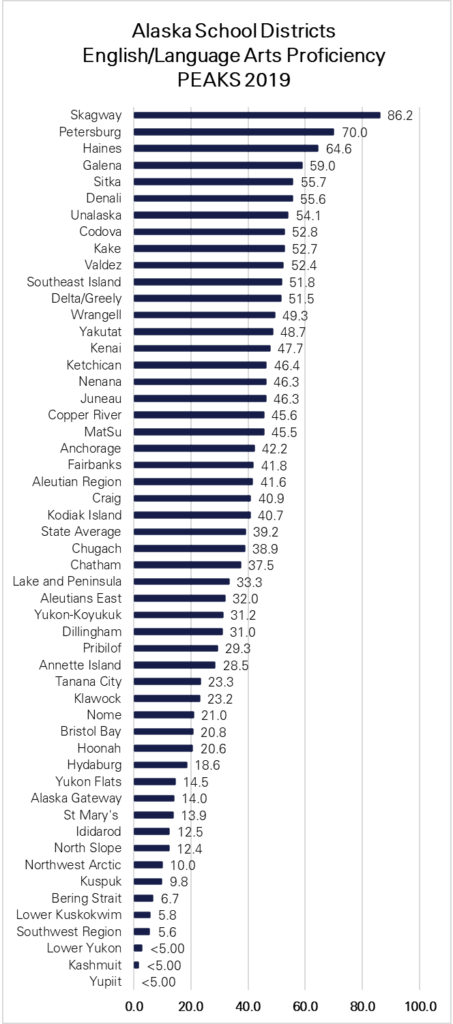
Myth 3: Poverty is the key contributor to Alaska’s dead-last in the nation score for 4th-grade reading for low-income and upper/middle-income students.
Reality: Alaska has a poverty rate significantly below the U.S. average (Figure 2). Mississippi has the highest poverty rate in the nation at 81% higher than Alaska, and was third in the U.S. in low-income NAEP reading scores in 2019. Mississippi was 44th the year it started its comprehensive reading policy in 2013. NAEP, the National Assessment of Educational Progress, is the nationwide standardized K-12 test that allows for comparison between states.
Figure 2
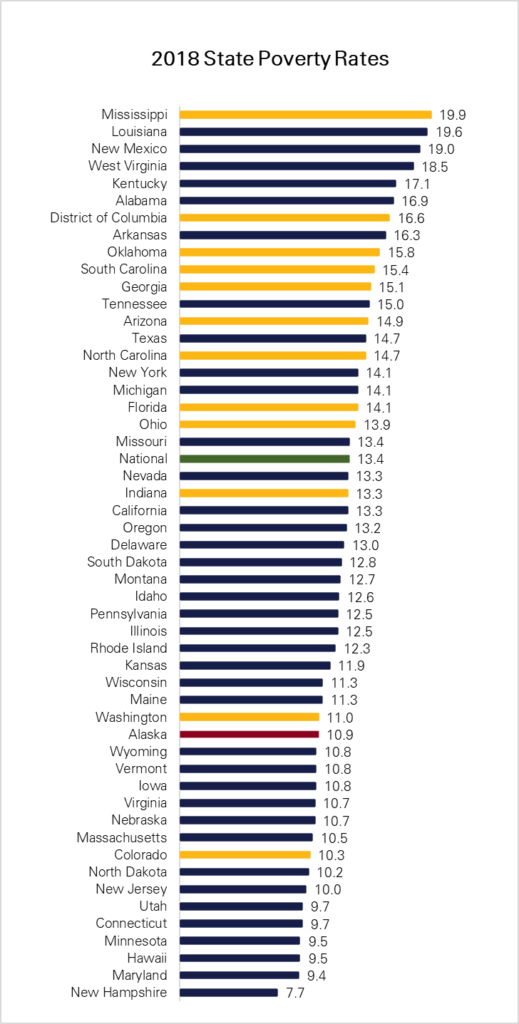
Myth 4: Ethnic minorities are primarily responsible for our low NAEP scores, and white Alaskan students score above average.
Reality: This is an offensive narrative that was promoted by some in the media in 2019, and was repeated on the floor of the Alaska State Senate that year. The truth is that white upper/middle-income students in Alaska had reading scores that were second to last in the U.S. in 2019 — significantly below the national average for that group (Figure 3).
In 2019 NAEP reading scores for white upper/middle-income Alaskan 4th graders were statistically indistinguishable from scores posted by Miami-Dade Public Schools (MDPS) 4th graders. MDPS is a very large urban district with a student body of around 350,000 that is comprised of 93% ethnic minorities, 66% free or reduced lunch, and 60% of their students come from homes where English is not the only language spoken.
Figure 3

Myth 5: We don’t have to worry about our 4th-grade NAEP reading scores because Alaska has above average growth in NAEP reading scores between 4th and 8th grade and our SAT and ACT scores are above average.
Reality: Though Alaska does experience above average growth between 4th and 8th grade, our 8th grade NAEP reading scores were still 49th out of 51 for upper/middle income students and 50th for low-income students, about one full school year behind the U.S. average (Figure 4).
In 2019 Alaska’s white upper- and middle-income 8th graders had NAEP reading scores that were only five points (about ½ school year) ahead of white upper- and middle-income 4th graders in Washington DC (the best in the nation).
Although the average SAT score for an Alaskan student was above the US average; the participation rate of 41% was below that of most states. With that low participation rate, there is a self-selecting enriched sample of college-bound students taking the test so we should expect the scores to be relatively high.
Not surprisingly, Alaska had an average SAT score that was lower all 20 states with a lower participation rate except New Mexico. More surprising was that with a 41% participation rate Alaska scored lower than four states with higher participation rate: Oregon (51%), Hawaii (54%), North Carolina (51%) and Virginia (68%).
Alaska’s under-performance in 2019 ACT scores is more dramatic. With a 38% participation rate, Alaska scored lower than all of the 20 states with lower participation rates. But also scored lower than 15 of the 30 states with higher participation rates — including five states with participation rates above 82%: Minnesota, Missouri, Nebraska, North Dakota, and Ohio.
References:
Average SAT Scores by State (Most Recent)
Average ACT Scores by State (Most Recent)
Myth 6: Pre-K improves NAEP scores more than comprehensive reading policies.
Reality: Alabama has had the highest quality pre-K system in the U.S. for the last 13 years according to the National Institute for Early Education Research (NIEER). Unfortunately, that investment in high quality has not seemed to pay off in NAEP scores. Over the last 13 years Alabama has fallen from 47th to 50th in low-income 4th-grade NAEP reading scores. Alaska is the only state that scores lower.
Florida was #1 in the nation in low-income 4th-grade NAEP scores before their first pre-K students took the NAEP in 4th grade. Florida added a comprehensive reading policy in 2002 that included performance-based promotion as an intervention strategy. In 2003, Florida was 28th in the U.S. in NAEP 4th-grade reading scores and rose rapidly to #1 in the U.S. by 2009. State provided and funded pre-K in Florida didn’t begin until 2005. The first Florida pre-K cohort was still in 3rd grade when Florida 4th graders were testing number one in the nation.
Myth 7: States that use the Florida 3rd-grade reading model with performance-based promotion saw their test scores increase in 4th-grade reading but didn’t see improvement in 8th grade scores or math scores.
Reality: Scores for 8th graders take several years to materialize for a reading policy that’s focused on K-3 reading. As the early leader in comprehensive reading policy, Florida is now starting to see dramatic improvement in 8th grade NAEP reading scores, as well as NAEP math scores. In 2003, Florida ranked 38th in the U.S. in low-income 8th-grade reading NAEP scores — by 2019 Florida was 5th in the U.S. In Florida 4th-grade low-income NAEP math ranking went from 30th to 1st between 2003 and 2019. Low-income 8th-grade math scores in Florida went from 40th to 25th. Florida has seen substantial growth in all eight NAEP measurements since 2003 (Figure 4).
In 2003, Alaska was significantly ahead of Florida in 8th-grade math for both low-income and upper/middle-income students. By 2019, Alaska didn’t rank above 45th in any NAEP measurements in 4th or 8th grade reading or math for low-income or upper/middle-income students, and Alaska has declined in standing in all eight of those NAEP measurements since 2003.
Figure 4
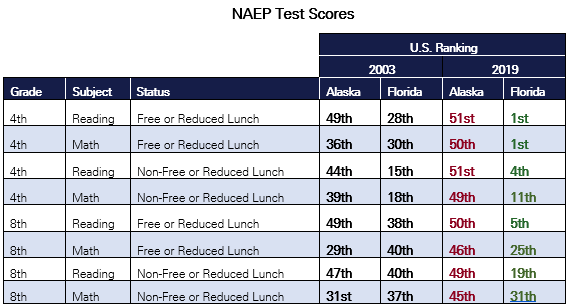
Myth 8: With a comprehensive reading policy that socially promotes very weak readers, Alaska’s students can still achieve NAEP scores near the U.S. average in a few years.
Reality: Of the 23 states with statewide reading policies that have used the approach of socially promoting very poor readers, the average reading NAEP score increase for low-income students was only 0.7 points over the last 16 years. In Alaska, low-income students are now 18 points below the U.S. average. Upper/middle-income Alaskan students are 12 points below the U.S. average. A 0.7 point increase would leave Alaska still firmly at the bottom.
In the 14 states that have state reading policies which require at least minimal reading proficiency to be promoted to 4th grade, the average 4th-grade low-income NAEP reading growth was 9.8 points over the last 16 years — or 14 times faster than states with social promotion (Figure 5).
Figure 5
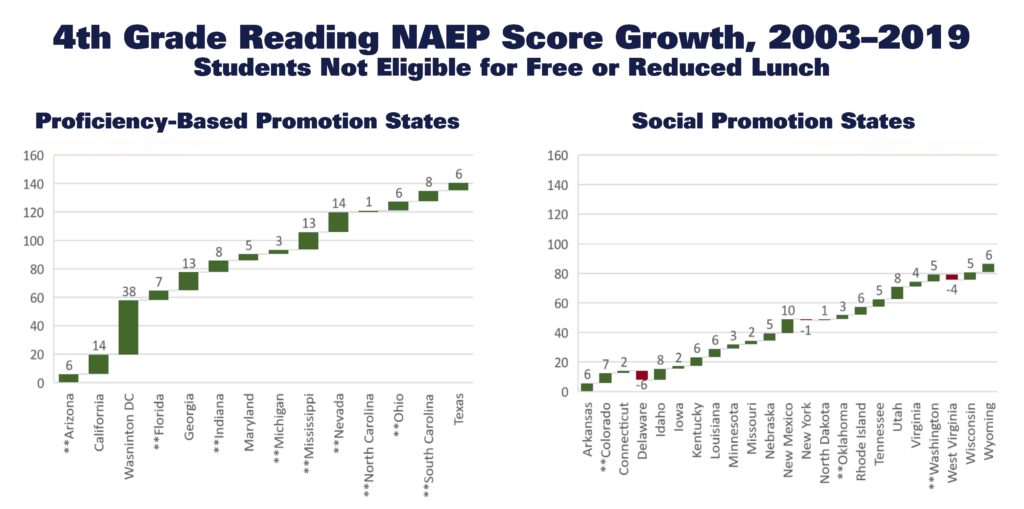
Myth 9: Florida and Mississippi dramatically increased their per student spending to add universal pre-K and a comprehensive reading policy.
Reality: According to NEA Rankings and Estimates, Florida increased per student expenditures about 52% and Mississippi about 57% between 2003 and 2018 – very close to the national average percentage increase for that period. In that same time period, Alaska increased per student spending more than 90%. Florida and Mississippi recognized that early childhood literacy was the highest priority of their educational system, and reallocated resources from other programs to fund early childhood literacy efforts with very little additional revenue (Figure 6).
Figure 6
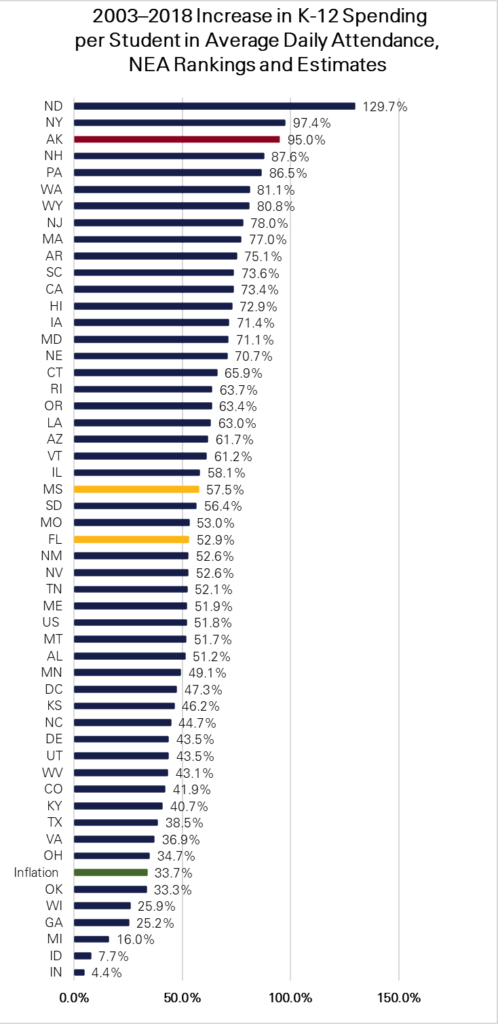
Myth 10: If we socially promote students who are far below grade level in reading at the end of 3rd grade, they still have a good chance of “catching up” later.
Reality: Experience has shown us that children who are not ready to “read to learn” by the beginning of 4th grade are very unlikely to catch up. More often, they fall further behind grade-level expectations each subsequent year. They simply lack the reading skill to keep pace with grade-level expectations and are much more likely to either drop out or develop coping mechanisms that manifest in undesirable behavior.
According to a 2011 report from the Annie E Casey Foundation:
- Children who are not reading proficiently by 3rd grade are four times more likely to drop out of school.
- Poor black and Hispanic children who are not proficient readers are eight times more likely than proficient readers to drop out.
- Dropouts are not eligible for 90 percent of jobs in the economy, and drop-outs make up nearly half the head of households on welfare.
Conclusion
We know there is no scientific reason that more than 10% to 15% of our students should be below grade level in reading by the end of 3rd grade. Yet, 63.3% of Alaska’s 3rd graders were not proficient in ELA last school year and over one third (35.4%) were in the lowest category of “far below proficient” according to state PEAKS testing.
To ensure that Alaska’s 3rd graders aren’t left far behind other states, reading reform should include proficiency-based promotion. My hope is that a properly structured Alaska Reads Act will be exceptionally effective, and our students will excel and reach their full potential.
**********
Bob Griffin is the Senior Education Research Fellow for the Alaska Policy Forum and a member of its Board of Directors. He’s a retired USAF fighter pilot and former Chair of the Budget Advisory Commission for the Municipality of Anchorage and the Anchorage School District and a current member of the Alaska State Board of Education and Early Childhood Development.
 Myth 1: ALL research indicates students should ALWAYS be socially promoted, even if they are far below expected proficiency in reading in 3rd grade.
Myth 1: ALL research indicates students should ALWAYS be socially promoted, even if they are far below expected proficiency in reading in 3rd grade.